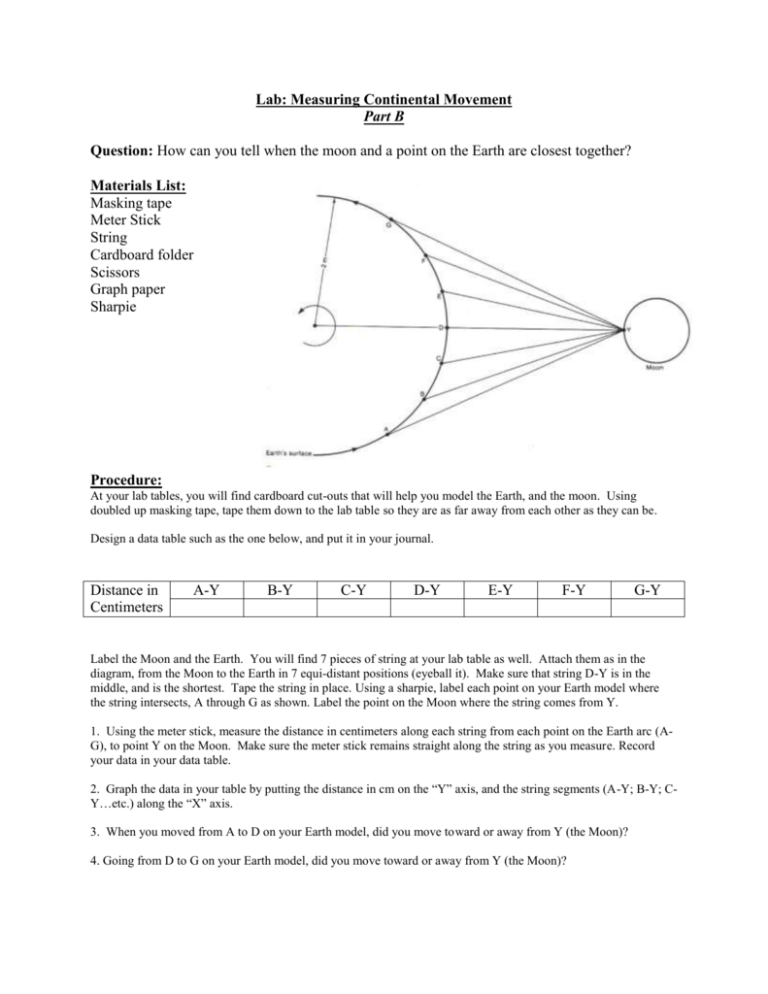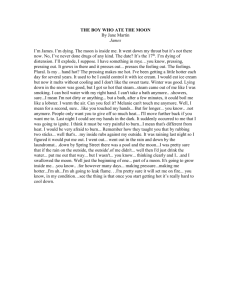Lab: Measuring Continental Movement
advertisement

Lab: Measuring Continental Movement Part B Question: How can you tell when the moon and a point on the Earth are closest together? Materials List: Masking tape Meter Stick String Cardboard folder Scissors Graph paper Sharpie Procedure: At your lab tables, you will find cardboard cut-outs that will help you model the Earth, and the moon. Using doubled up masking tape, tape them down to the lab table so they are as far away from each other as they can be. Design a data table such as the one below, and put it in your journal. Distance in Centimeters A-Y B-Y C-Y D-Y E-Y F-Y G-Y Label the Moon and the Earth. You will find 7 pieces of string at your lab table as well. Attach them as in the diagram, from the Moon to the Earth in 7 equi-distant positions (eyeball it). Make sure that string D-Y is in the middle, and is the shortest. Tape the string in place. Using a sharpie, label each point on your Earth model where the string intersects, A through G as shown. Label the point on the Moon where the string comes from Y. 1. Using the meter stick, measure the distance in centimeters along each string from each point on the Earth arc (AG), to point Y on the Moon. Make sure the meter stick remains straight along the string as you measure. Record your data in your data table. 2. Graph the data in your table by putting the distance in cm on the “Y” axis, and the string segments (A-Y; B-Y; CY…etc.) along the “X” axis. 3. When you moved from A to D on your Earth model, did you move toward or away from Y (the Moon)? 4. Going from D to G on your Earth model, did you move toward or away from Y (the Moon)? 5. Look at the graph you created in your journal. Estimate the distance (in centimeters) to Y if you are located between B and C on planet Earth. 6. Now, try to draw a reasonable line through the points on your graph. You can see that the line is curved. What best explains why the line is curved? Think about the Earth and the Moon. The Earth rotates, so a fixed point on the Earth moves beneath the Moon. [The Moon does move slowly, but at this moment consider it fixed just as Y (the moon) was fixed]. Consider this one of the sources of error in this model! One moment you are at A relative to the moon, the next moment at D and third moment at G. How can you tell when the moon and a point on the Earth are closest together? In the table below, you have been given data to plot on a graph. Look over this table. This data is an example of the distances to the moon which would be measured by a laser ranging station located on the equator in South America. Notice that the Earth-moon relationship in figure 3 is similar to what you measured earlier. 7. On another piece of graph paper, plot the data from the table above. Put the distance of the moon in km along the Y axis, and the time (starting at 6am and going to 10 pm) on the X axis. Using figure 3, note that a particular point on the Earth’s surface, the center of the Earth, and the moon lie on a straight line only at one particular time during the day. At that time, this point is closer to the moon than it is at any other time. 8. On a Pacific island, on the equator, another class of students is doing the same activity. The moon passes their meridian exactly four hours later. Plot the curve of their observations on your graph in question 7. (Plot the same curve, but everything should be moved to the right 4 hours). Look at Figure 3. Notice the points when the moon is on the meridian. In South America the time was 12 noon; on a Pacific island the time was 4 hours later. How far is the South American station from the Pacific island? To answer this question we need to know how far a point on the equator rotates in one hour. Astronomers tell us this is about 1700 km. So the distance from the South American station to the Pacific island station is 1700 x 4 = 6800 km. 9. Suppose that astronomers continue to make this same measurement for ten years. Suppose that by ten years later the time difference between when the moon is on the meridian at the two locations has become .001 second longer than four hours. The equipment is operating perfectly; what could account for that difference? 10. How far does a point on the Earth’s surface move in .001 second? Distance = rate x time. Rate = 1700 km/hr or about 500 m/sec Distance = 500 m/sec x .001 sec = ______ m or ________ cm in 10 years; _______ cm in one year. This is about as fast as your toenails grow. Do continents drift apart at that rate? Geologists suspect so but they don’t know for sure. That’s why they are trying the laser ranging experiment! Analysis Questions: 1. Explain why geologists cannot measure the distance between continents by line-of-sight measurements. 2. When a point on the Earth is closest to the moon, the moon is on the… 3. If we know the time when the moon is on the meridian at two locations on the same parallel, what can we find? 4. The moon is on the meridian at an observatory in the Hawaiian Islands at 12:00 noon. It is on the meridian at an observatory in Hong Kong at 6:00 p.m. Ten years later the time difference is .001 second shorter. What do you think is happening?







